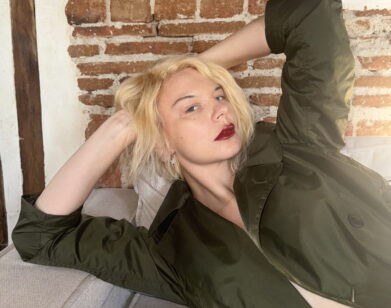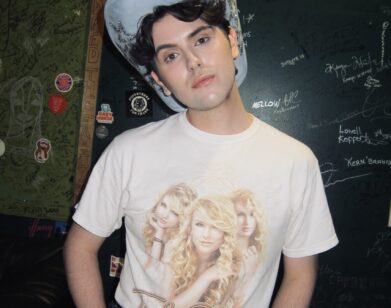Pantha du Prince’s Bell Hooks

ABOVE: HENDRIK WEBER, AKA PANTHA DU PRINCE.
A carillon, for those who haven’t heard one before, is an absolutely massive instrument. Weighing three tons, and comprised of 50 bronze bells, it’s just about the last thing you’d ever associate with a club DJ. Hendrik Weber, who records music under the name Pantha du Prince (among others) sees things differently. After hearing the carillon echo through the city streets of Oslo, Norway, he immediately felt drawn to the clamorous tones and soon found himself attempting to compose his own music using the instrument. After figuring out the logistics (“It’s just a huge-ass truck that carries one instrument”), he teamed up with a group of classically trained musicians known as The Bell Laboratory and got to work.
“I wanted to push the limits of one concept,” says Weber about making the resulting record, Elements of Light. “For me, it was important that it was one piece and not tracks. What usually goes into six minutes is now on 44 minutes. Like a DJ mix led by an ensemble.” And that is exactly what the record sounds like: tracks with names like “Spectral Split” and “Quantum” blend into one another, as marimba, chimes, xylophone, and various percussive elements come in and out of play. It’s still unmistakable Pantha du Prince and contains shades of the minimal techno and house Weber is known for, yet it’s also unlike anything he’s attempted. It’s a mix that he refers to as “archaic tribalism”—of weaving together disparate sounds and concepts while keeping the dance-music edge. “It’s not this abstract club thing, where you don’t have this direct physical connection to a sound,” he says. Read on for more on the Weber’s process working with the carillon, the music he connected to as a child, and what defines the ever-changing landscape of Pantha du Prince.
NATHAN REESE: So, first, tell me about the carillon. When did you first get the idea to use the instrument?
HENDRIK WEBER: It started in Oslo when I was having lunch with [local curators Mattis With and Håkon Vinnogg], and I heard the carillon of the city town hall. I was surprised by how good the sound was, and how musical what I heard was. I was like, “This is fantastic! This sounds great!” [They were] like, “Yeah, we can do a project with this instrument. We do it often with new music events.”
REESE: So that’s when you had the idea for the record?
WEBER: Well, first I had thought about doing a geographical mapping of Oslo, with the melody played by the carillon. We would record it in the city and make an interactive map, where you could place yourself on certain spots and hear the melody. I also had this idea of the eco-load—acoustic mapping of your surroundings. [We] talked to some musicians, who were excited about working with me and with bells. So we were like, yo, we should extend this whole project to a whole other level. We should bring the carillon from the tower—I mean, symbolically—and then put it into an ensemble so we will be able to play the piece anywhere.
REESE: How did the Bell Laboratory get involved?
WEBER: I started working on the music, and I met with the musicians, and with the composer, [Lars Petter Hagen]. It was not about an art project anymore. It was an ensemble where we would explore how we can use bells with classically trained musicians, new music musicians, and jazz musicians. I knew what they could do after a while, and I started getting into the flow. I wrote like I normally do, but very much stripped down—more like a skeleton of a 40-minute track that had four parts. [That’s] how the whole thing came together.
REESE: You’ve been interested in field recordings for a long time, but is this the first time you heard something in the real world and then actually brought it into the recording studio to play?
WEBER: That’s interesting. That describes the process. There was this moment, where I was like “Okay, what’s going on?” Then afterward, we tried to explore this moment where something happened. I like to picture this thing up in the air, the sun shining through, the light hitting in when you look up.
REESE: How many people play live for the project?
WEBER: On stage we are five musicians plus me, so six musicians. During the recordings the composer also joined, so it was seven people. It was all recorded live in one run: 44 minutes, of course with overdubs.
REESE: How did it feel moving further away from dance music? Was it a natural evolution?
WEBER: It just happened like that. It wasn’t planned or anything. It’s just, if you work with so many classical instruments… I mean, it still has this power, and it’s still connected to the idea of techno. But it has its own quality, its own sound. It’s in between, even more than the record before. You need to give every instrument, sound, and element the space it needs.
REESE: How do you think fans of Black Noise, or your older stuff, will react to Elements of Light?
WEBER: I try to keep things in the concept of Pantha du Prince—or what it is for me. Taking elements of all kinds of music that I’m interested in, and trying to connect them, and give them a certain system of knowledge. This is, for me, Pantha du Prince still. And there’s so much more possibility within this frame.
REESE: What sort of music did you listen to growing up? Was it mostly techno?
WEBER: I’ve listened to all kinds of music since I was a child. My father was more into psychedelic and classic ’60s stuff, and my mom listened to classical music. There was a long jazz period and then a long electronic and industrial, electro-acoustic [stage], and shoegaze. Then there was techno. Really it was a big variety, I’m not attached to a certain scene. There was certain music—and techno was a part of it—that really formulated something for me, that really was a direct connection to what I experienced in my life. Going to parties and listening to techno at home helped form my musical identity. And that changed throughout my life.
REESE: Where did the album title come from?
WEBER: At the first moment, the title was there. There was the question: “What is light? What makes us see? What is behind this phenomenon?” Also, I connected to the bell as an instrument. Light and bells are kind of a symbol for each other, in a way. Also, the process of creating a bell is intense. They are burned, and all the elements are part of the process. The sound symbolizes this process of creating this instrument. It’s all part of a moment that you recognize after, what went through you, kind of.
REESE: Did you play any of the carillon on the album?
WEBER: No, no. The person playing is who was playing when I first heard it, [Vegar Sandholt]. He’s still the guy playing in the bell tower in Oslo.
REESE: It’s a huge instrument, how can you take it on tour with you?
WEBER: Well, there’s a mobile carillon. I found out about a mobile carillon in Copenhagen, and we just rented it from this guy who is really nice and really interested in the project. We’ve played it four times now—it’s not such a big thing. We’re in the normal booking process. We’ll definitely do some festivals and some theaters.
REESE: Has the live experienced changed a lot?
WEBER: I’m already used this more concert-type situation. In Europe and North America, 50 percent of the gigs are concert situations, so it’s not so far from what it developed into. It’s really a lot of fun to see that this music can actually survive, that it can be concert music. My solo shows are already going along that path. You have the freedom to basically push to party, or you can tell a story from nothing with soundscapes, moving images, to a real party mood. At some concerts, people get out of their seats and start dancing after a while.
REESE: Are you mostly playing theaters?
WEBER: We’ve played two shows with seated audiences, and two with a standing audience. Both were cool. Sitting is more mental, in a way, [but] after a while they really want to get up and move. It’s very euphoric, I think, because people see what’s actually going on. The energy takes over.
REESE: You could have made the whole album just sampling the sound of carillon; what made you want to use the actual, physical instrument?
WEBER: Right, I could have made the same album without the musicians. But it’s about the process for me. It’s about the sculpture. The idea of the record is that it’s a statement for working with a group, of a collaborative work. That should be visible in the music.
REESE: Did you like working in a more collaborative environment?
WEBER: Yeah, I like the process of giving control away. When you give it up to people, it’s another intelligent organism that digests your information completely differently from how a machine digests information. It’s like you’re on a sailboat, and every time you can find out how to better adjust [the sail] to make it more precise. And it’s interesting to see that the musicians have their own ideas. To use their intuitive power with their knowledge that they incorporate into the music. This is the moment you give away control, you give it to someone else’s intuition. To find this path is different than from controlling a machine. It’s more human.
ELEMENTS OF LIGHT IS OUT TODAY VIA ROUGH TRADE. FOR MORE ON THE ARTIST, VISIT HIS WEBSITE.






